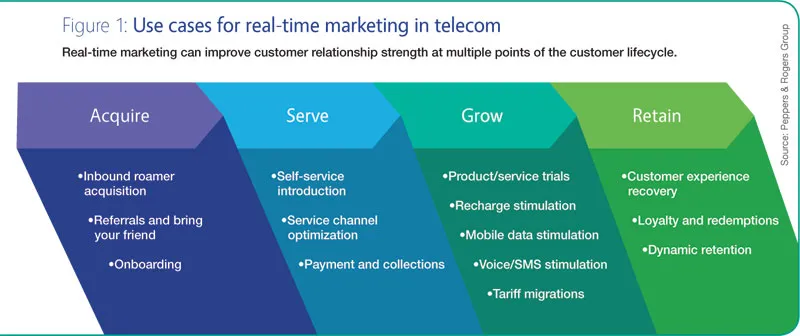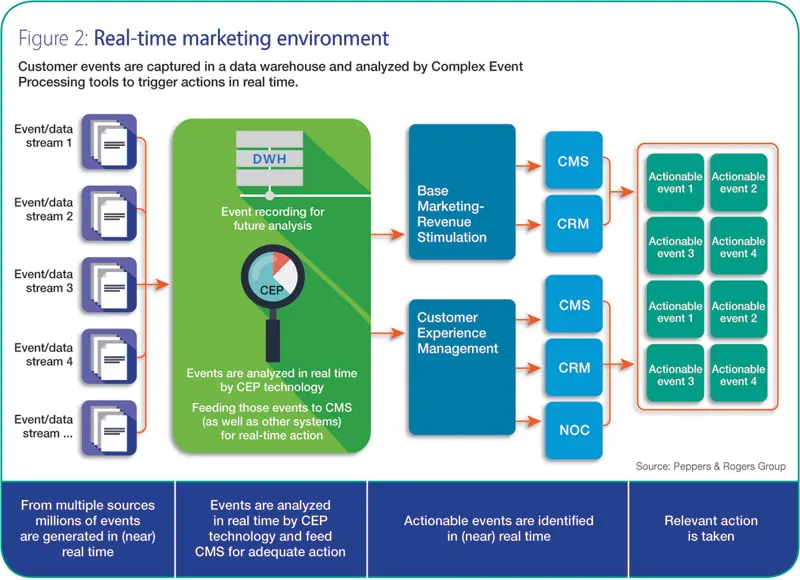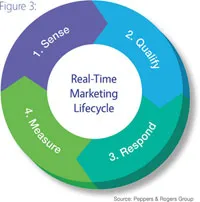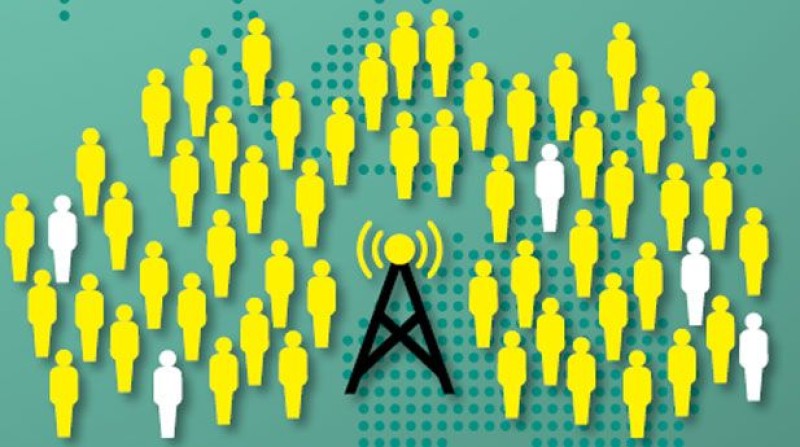T-Mobile made a splash this year in the U.S. with its campaign to pay customers' early termination fees if they switch to the hot pink operator. AT&T, meanwhile, is offering T-Mobile customers up to $450 to switch. And Sprint created a new friends and family "Framily" plan to entice people to sign up as a group for increased savings.
And, that's just in the U.S. Operators around the world are trying to stay ahead of the competition with new acquisition strategies that steal customers from one another. Many of these programs focus on short-term, price-based promotions that may ultimately undercut profitability.
Acquisition is important, but not the only thing. Retention is critical to the long-term health of any company, particularly in the competitive telecom space. That's why programs such as real-time marketing can be a boon to companies looking to build relationship strength with the customers they already have.
Real-time marketing is defined as the combination of behavioral analytics and automated marketing to provide customers with the right offer at the right time based on specific customer behaviors. Using what you know about an individual customer or segment, you can sense and respond in the moment to serve their needs. We at Peppers & Rogers Group believe that companies that harness the potential of real-time marketing will reap significant benefits through improved response rates, Net Promoter Scores and return on investment.
For example, European airline KLM recently conducted an experiment called KLM Surprise to strengthen its emotional bond with customers. Flight attendants monitored social media to identify customers who mentioned they were planning a trip with the carrier. Using information provided online by the customers, the company purchased personalised gifts that were presented to customers upon their arrival at the airport. In one instance, a passenger received an iTunes gift card after tweeting about his excitement to use his new iPad on his KLM flight. Despite only 40 passengers being given gifts, word-of-mouth and social mentions resulted in KLM's Twitter page being viewed more than 1 million times in November 2013 alone.
KLM is an interesting example, but only one of few companies that are beginning to unlock the potential of real-time marketing as a competitive differentiator. It can be complex to implement the structured and systematic real-time marketing strategies, technologies, and processes needed to enable an immediate, direct connection with individual consumers.
In the telecommunications industry, real-time marketing remains a fairly new concept. With highly saturated markets, the challenge for operators is to create value year-over-year from their product portfolio and customer base. Through accurately targeting customers with highly customised offers, operators can generate value for customers while minimising existing revenue cannibalisation. This approach also enables operators to measure performance on a more granular level than is possible through mass marketing activities.
As seen in Figure 1, advanced marketing techniques can be used to enhance the operator-consumer relationship throughout the customer's entire lifecycle.

Customer interactions can begin in the acquisition phase, followed by pre-determined communications during the first 90 days of the customer's tenure, during which time studies have shown customers have the highest propensity to purchase additional products from the operator.
But perhaps the most advanced and exciting uses of real-time marketing are to maximise the value of existing customers. A simple practical example is the uplifting of customer recharge behavior. Under regular circumstances, a customer may recharge his pre-paid line and increase usage immediately after the recharge. As he gets close to his pre-paid limit, he will slow down usage. With an effective real-time marketing solution in place, operators can identify when the customer enters this low usage period and push an appropriately timed recharge offer to him. This will likely result in the customer recharging his line and using it freely again, thus boosting revenue for the operator.
What's behind the curtain?
Real-time marketing requires a complex and agile system to proactively respond to individual events, complex combination of events, and changes to the business environment. In telecommunications, these events can be system- or customer-generated (e.g., dropped calls, out of credit, high churn risk score, etc.). The changes can be automatically captured and acted upon based on specific business rules and processes, or may require human intervention after being flagged. It should designed to continuously evolve and adapt, operating as a re-iterative, test-and-learn operating model to ensure the impact of the triggering events provides important lessons for future decisions.
Its implementation involves integrating multiple systems; some of which operators may be introducing for the first time. The solution architecture is of paramount importance to ensure the business can benefit from continuous scalability as well as performance (see Figure 2).

From a marketing perspective this system should enhance the operational responsiveness to real-time events, for both everyday marketing activities or enhanced customer experience management. Defining triggers and rules for actions will rely on both real-time and historical data to enhance the action or decision deployed. As such, the system needs multiple information sources as inputs. They may include:
• Network and location data
• Customer behavior, profile, and subscription data
• Campaign response data
• Social media
• Voice of Customer: speech analytics, surveys, complaints, etc.
Each company can define its own specific events (real-time and historical) to be captured and feed the relevant systems for processing and triggering actions. Common systems used include complex event processing (CEP), campaign management (CMS), network operations centres (NOC), and customer relationship management (CRM). Events related to customer experience management may involve multiple systems. For example, dropped calls captured for a high-value customer may trigger a campaign and additional priority events. This requires full interoperability among the different platforms.
With the requisite enablers in place, operators will be fully equipped to perform the tasks at each stage of the real-time marketing lifecycle (see Figure 3).

1. Sense: Define scenarios or use cases for real-time events and customer behavioral patterns to be recognised by the system, then incorporate one or more elements into each scenario. They may include:
• Telecommunications usage
• Revenue and billing
• Recharge
• Devices
• Network
• Social media
• Customer service interactions
• Loyalty transactions
2. Qualify: Explore customer data to identify instances of pre-defined use cases and scenarios defined in Stage 1 on a real-time basis. Optimise action thresholds to be used to respond to actions by maximising the value provided to the customer and minimising revenue cannibalisation risk.
3. Respond: Trigger specific action based on patterns of activity detected during the Sense and Qualify stages. Decide the best way to target them at the right time and through the right channel. Responses should be designed to stimulate revenue generated by customers, retain customers, generate customer loyalty, and improve the customer experience.
4. Measure: Leverage test-and-learn methodology to adapt use cases and scenarios through analysing the impact of real-time marketing actions on revenue, profitability, and customer satisfaction. Incorporate the feedback loop back to Stage 1 to review action thresholds and optimise them to maximise impact of activities.

Four barriers to real-time marketing success
Peppers & Rogers Group conducted market research to identify the main pain points faced by telecommunications operators attempting to convert the plethora of data available to them into actionable insights resulting in value creation. Four distinct categories of challenges emerged: data environment, internal capabilities, visibility, and culture and coordination.
Within the data environment, it's common to see data from multiple sources found in silos, resulting in a fragmented and incomplete view of customer behavior. In addition, operators must ensure their data is stored in a manner that supports easy retrieval, manipulation, and analysis. Quality and usability issues are also extremely common, typically concerning the completeness, consistency, and accuracy of data held in operator systems.
What to do: Define an effective data strategy to transform the plethora of data available into actionable information. It is vital to couple, effective data quality management with the creation of clearly defined datamarts that integrate siloed data. Systems must speak to each other in real time or near real time so operators can act at the right moment.
Many operators have not yet developed their internal analytical capabilities to a level to properly optimise marketing activities. Even simple insight generation is missing at a number of telecommunications operators. Many struggle with effective systematic reporting and generating insights from their data. Organisations must be capable of leveraging customer insights to drive their daily marketing activities.
What to do: Turn data into insights. Companies can analyse real-time data to determine the correct threshold or trigger to launch a marketing campaign or other communication.
When it comes to visibility of real-time marketing insights, many operators are unable to answer the most important question of "So what?" Identifying potential value creation opportunities provides a challenge due to the lack of effective technology and analytical capabilities.
What to do: Operators can identify the optimal channel and response for each customer action with a test-and-learn approach. The end goal will be a library of responses with defined channels for each real-time marketing trigger.
And finally, a major stumbling block is culture change. Companies are often unable to understand the value of real-time marketing, believing mass marketing initiatives generate sufficient value. A second cultural difficulty lies in internal motivation. In order to generate additional value, additional effort is required from internal resources. And as with any cross-functional initiative, coordination among multiple departments can get complicated.
What to do: Key stakeholders must be engaged at an early stage of the journey in order to achieve organisational buy-in. A clear roadmap detailing expectations will also build urgency and cooperation. Also, any programs should include a workflow management component to break down barriers among departments.
Conclusion
With so much data being collected and analysed these days, consumers will come to expect real-time interaction from all companies they do business with, especially telecoms. Leading operators understand this and will put the strategies, technologies, and operations in place to enable real-time marketing activities to help meet those changing expectations.















